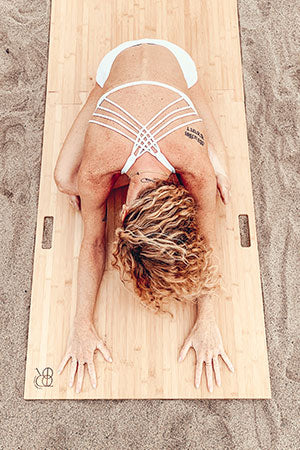WORKSHOP: Exercises to Build Strength and Balance

Have you shied away from standing yoga balances in your practice because you're working on carpet or an uneven surface outside? Standing balances like tree pose and Warrior III can be difficult all on their own; add a soft, unsteady surface underneath your feet, and the poses have become even less desirable to be included in the practice rotation. The Root Board provides you with the opportunity to confidently work on your balance without the additional challenge of working on carpet, sand, or land. In fact, with the Root Board, you can add in a whole repertoire of movements that help you balance better that you may have been missing out on since leaving the studio floor. Once you have your Root Board, put it together and give this sequence for better balance a try.



Place your washcloth on the floor under your right foot. Feel how the surface of your right foot makes contact with the cloth. Then, compare how different the sensations are between your right foot on the fabric and your left foot on the Root Board. Bring your awareness back to your right foot and lift and lower your right toes a few times. Then, lift your right toes and, one by one, lower your toes, starting from the big toe to your pinky toe. Lift your right toes again and flutter them down from the pinky to the big toe. Let your toes rest. Place your awareness on the arch of your right foot and try to scrunch up the washcloth. Notice how the muscles of your feet react to the stimulus of grabbing the washcloth. Once your foot begins to fatigue, remove the washcloth and stand in Tadasana. Observe how your right foot feels compared to your left. Does your right foot feel warmer, more stimulated, stronger, and so on? Do you feel like your brain is slightly more connected with your right foot than your left like you can perceive where the right foot is better in space and relationship with the rest of your body? After a thorough observation, take the washcloth under your left foot and practice on the left side.


In yoga, you may often be asked to balance on one leg for about five breaths, which can be intimidating and even make the body stiff, doing whatever you can not to let that foot drop. By alleviating the pressure of standing on one foot, you may notice a shift in how you approach balancing and build confidence on one foot.


Begin standing in Tadasana with your feet hip-width apart. Shift your weight onto your right foot and feel how the surface of your right foot makes solid contact with the Root Board. Draw the left knee up, as if by a string, lifting the left foot any amount away from the floor. Once the knee reaches the pinnacle of movement, with control, lower the foot to the board and switch sides. Repeat this a few times, and then if you would like to make the holds longer, try holding the leg up for one full round of breath, followed by two and so forth.

Now that you've awakened your feet and tested the balancing waters, the sliding circle lunges will build more heat in your body and strengthen the muscles of your legs and hips for balance.





Ardha Parsvottanasana is an asymmetrical, standing forward bend requiring balance, though both feet are fixed to the floor. This asana is a good break from some of the active work you've been doing and prepares Warrior III's shape.


Grab your two blocks and place them at the top of your Root Board. Step your right foot back 3-4 feet with your back foot slightly turned out. Your heels can be aligned or have your feet wider apart. Place your hands on your hips and bend your front knee. Fold at your hips so that your torso comes halfway done and parallel with the floor. Stretch the sides of your body forward. Release your hands to the blocks, maintaining the half upright position. Reinforce driving your heels into the floor. So long as you retain this shape, straighten your front leg more or until it is straight. To come up, bend your front knee, place your hands on your hips and come up with a long spine, lifting through the sides of your body.


Now you've arrived at the pinnacle of the sequence and reuniting with your balancing practice. This Warrior's variation allows you to explore the posture, balance and customize it to your practice preference.







